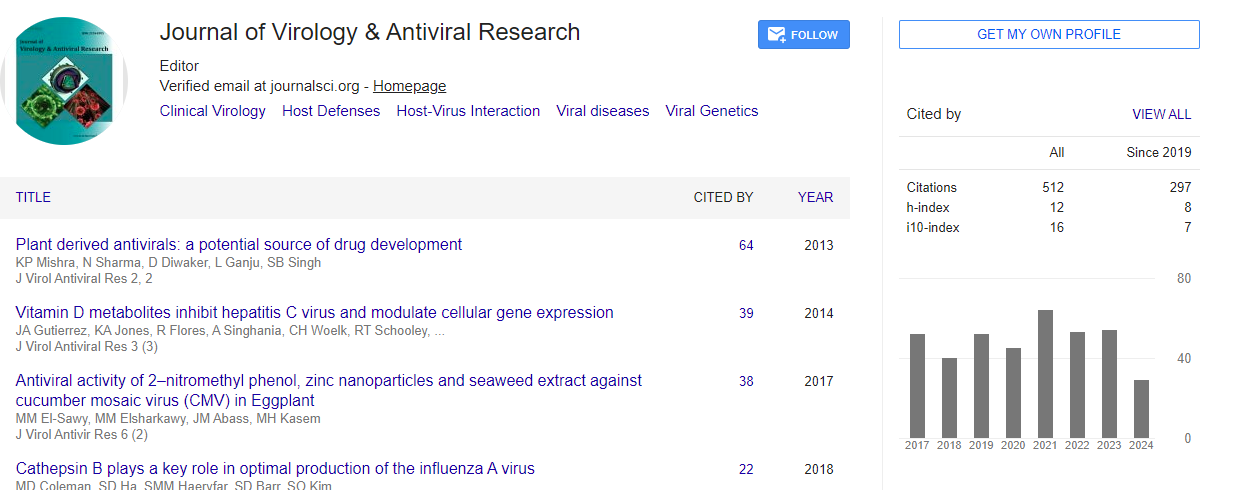Commentary, J Virol Antivir Res Vol: 13 Issue: 1
RNA Interference: The Silent Revolution in Medicine
Patrick Lanier*
1Department of Regenerative Medicine, University of Texas at Austin, Austin, TX, USA
*Corresponding Author: Patrick Lanier,
Department of Regenerative Medicine,
University of Texas at Austin, Austin, TX, USA
E-mail: patricklanier@utexas.edu
Received date: 26 February, 2024, Manuscript No. JVA-24-137566;
Editor assigned date: 28 February, 2024, PreQC No. JVA-24-137566 (PQ);
Reviewed date: 14 March, 2024, QC No. JVA-24-137566;
Revised date: 22 March, 2024, Manuscript No. JVA-24-137566 (R);
Published date: 28 March, 2024, DOI: 10.4172/ 2324-8955.1000697
Citation: Lanier P (2024) RNA Interference: The Silent Revolution in Medicine. J Virol Antivir Res 13:1.
Description
RNA Interference (RNAi) technology has emerged as a powerful tool for modulating gene expression with profound implications for both basic research and therapeutic interventions. This study provides a comprehensive overview of RNAi technology, elucidating its molecular mechanisms, experimental applications, and therapeutic potential. By harnessing the natural RNAi pathway, researchers can selectively silence target genes, offering novel avenues for studying gene function and developing RNA-based therapeutics. This manuscript discusses the latest advancements in RNAi technology, highlighting its versatility in diverse fields, including functional genomics, drug discovery, and precision medicine.
RNA Interference (RNAi) is a conserved cellular mechanism that regulates gene expression through sequence-specific degradation of target mRNAs. Discovered in the late 1990s, RNAi has since revolutionized molecular biology and emerged as a promising therapeutic approach for treating a wide range of diseases. This section introduces the concept of RNAi technology and outlines its significance in deciphering gene function and developing targeted therapeutics.
At the heart of RNAi technology lies the intricate molecular machinery responsible for gene silencing. This section delves into the molecular mechanisms of RNA interference, including the biogenesis of Small Interfering RNAs (siRNAs) and microRNAs (miRNAs), the assembly of RNA-Induced Silencing Complexes (RISCs), and the target mRNA division or translational repression. Understanding these mechanisms is essential for harnessing RNAi technology for experimental and therapeutic purposes.
RNAi technology offers versatile experimental approaches for studying gene function and elucidating cellular pathways. This section discusses various RNAi methodologies, including synthetic siRNA and miRNA mimics, Short Hairpin RNA (shRNA) expression vectors, and genome-wide RNAi screens. Additionally, advanced delivery strategies such as lipid nanoparticles and viral vectors enable efficient delivery of RNAi therapeutics in vivo, overcoming barriers associated with cellular uptake and stability. RNAi technology has revolutionized functional genomics by enabling systematic interrogation of gene function on a genome-wide scale. This section highlights the applications of RNAi in functional genomics, including gene knockdown studies to elucidate gene function, identification of synthetic lethal interactions, and characterization of signaling pathways and cellular processes. Moreover, RNAi screens have facilitated the discovery of novel drug targets and biomarkers for various diseases.
The ability of RNAi to selectively silence disease-associated genes has sparked considerable interest in its therapeutic potential. This section explores the applications of RNAi technology in drug discovery and development, with a focus on RNAi-based therapeutics for cancer, viral infections, genetic disorders, and neurodegenerative diseases. Despite challenges such as off-target effects and delivery barriers, ongoing research efforts aim to harness RNAi technology for precision medicine approaches.
RNAi technology holds promise for combating infectious diseases by targeting essential viral or bacterial genes. This section discusses the application of RNAi in inhibiting viral replication, suppressing viral gene expression, and modulating host immune responses against pathogens. Additionally, RNAi-based strategies for combating emerging infectious diseases and drug-resistant pathogens are explored, highlighting the potential of RNAi as a versatile antiviral and antibacterial tool.
While RNAi technology offers tremendous potential, several challenges remain to be addressed for its widespread adoption in research and clinical settings. This section discusses key challenges such as off-target effects, immune stimulation, and delivery optimization, and proposes future directions for advancing RNAi technology. Strategies for improving specificity, enhancing delivery efficiency, and refining bioinformatics tools for RNAi design and analysis are essential for realizing the full therapeutic potential of RNAi.
Conclusion
RNA interference technology has revolutionized our understanding of gene regulation and holds immense promise for therapeutic applications across diverse disease areas. By harnessing the power of RNAi, researchers can uncover novel drug targets, develop precision therapies, and combat infectious diseases with unprecedented specificity. Continued advancements in RNAi technology are poised to transform the landscape of molecular medicine and improve patient outcomes worldwide.
 Spanish
Spanish  Chinese
Chinese  Russian
Russian  German
German  French
French  Japanese
Japanese  Portuguese
Portuguese  Hindi
Hindi 

